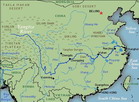2020 Yangtze River Cruise and Ferry Starting from 79 USD p.p.!
Shanghai Intoduction
A conurbation of over 18 million
people ,Shanghai is China’s second-largst
city and is one of the four centrally administered
cities in the country, the other three being
Beijing, Tianjin and 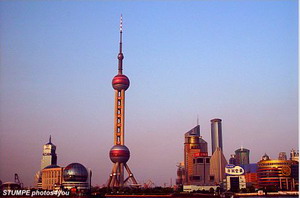 Chongqing.
It is also one of China’s most important
industrial and cultural centres.
Chongqing.
It is also one of China’s most important
industrial and cultural centres.
To most foreigner, Shanghai conjures
up stories of adventure and intrigue, of vice
and leasure. Many of these were probably no
exaggeration, for it was a dynamic,violent and
colourful city. Most of the European-style quarters
of the old international Settlement and the
French Concession areas can still be seen, though
they are much in need of repair. One can still
clearly imagine the extraordinary life of pre-1949
Shanghai.
HISTORY OF SHANGHAI
The name Shanghai, which means 'on
the sea', was first used in AD 960 when the
set dement was a backward fishing village. In
1554, the town was surrounded by a seven-metre
(23-foot) high crenellated city wall and a moat
to protect it against the frequent incursions
of Japanese pirates. By the l7th century there
were signs of growing wealth, but when the British
troops stormed its undefended walls in 1842
Shanghai was still only a county town of no
great importance.
The first foreign settlement was
established in 1843, when the newly-appointed
British Consul arrived to negotiate for a 138-acre
(just over 0.5 square kilometres) site north
of the existing city. This site was joined with
the American Settlement founded in 1848 north
of Suzhou Creek, to form the international Settlement
in 1863. Subsequent negotiations with the Chinese
increased the area of the International Settlement
to more than 5,500 acres (about 22 square kilometres).
The French Concession was established on 164
acres (about 0.6 square kilometres) in 1849
and was finally extended to about 2,500 acres
(about l0 square kilometres). The Japanese,
also, had secured a concession by the end of
the 1ast century, which became a centre for
cotton-spinning factories. These settlements
were self administered and were outside Chinese
government jurisdiction.
The old Chinese City, occupied by
one group of the Taiping rebels--the Small Sword
Society--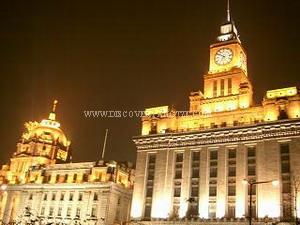 between
1853 and 1855, became the scene of lawlessness
and fighting. The foreign community, concerned
for its own safety, formed the Shanghai Volunteer
Corps, recruited from local traders and diplomats.
They were even prepared to take on the imperial
troops f backed by British and American officers
and men from visiting warship5, the volunteers
issued an ultimatum for the troops' removal,
an action which precipitated the Battle of Muddy
Flat in 1854. The imperial troops were duly
driven away from their encampment, which was
the site of the old racecourse, now the People's
Park.
between
1853 and 1855, became the scene of lawlessness
and fighting. The foreign community, concerned
for its own safety, formed the Shanghai Volunteer
Corps, recruited from local traders and diplomats.
They were even prepared to take on the imperial
troops f backed by British and American officers
and men from visiting warship5, the volunteers
issued an ultimatum for the troops' removal,
an action which precipitated the Battle of Muddy
Flat in 1854. The imperial troops were duly
driven away from their encampment, which was
the site of the old racecourse, now the People's
Park.
Shanghai was again threatened by
the Taiping rebe1s in the 1860s, but they were
quelled by the Ever Victorious Army made up
of foreigners and Chinese, estab1ished for this
very purpose. An American, Frederick Townsend
Ward, a Frenchman, Henri A Burg vine, and a
Briton, Char1es Gorge Gordon ('Chinese Gordon',
later of Khartoum fame), took successive command
and were all made officers of the Qing Imperial
Army.
The nationwide upheavals in the
20th century the 1900 Boxer Rebellion, the 1911
Revolution, the Sino Japanese War took their
toll on Shanghai's millions.Hundreds of thousands
of Chinese poured into the foreign settlements
for protection and then stayed on. Nevertheless,
Shanghai continued to flourish as an entrepot
with its staple exports of tea and silk, and
imports of piece goods and opium. Banking plyed
an important part in this great trading city,
which had its own stock exchange. 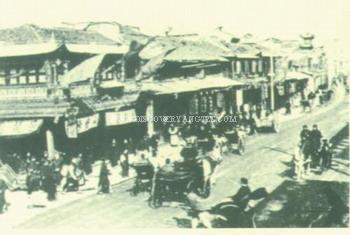
The foreigners' lifestyle was grand and
lavish for those who could afford to participate
in clubs, race meetings, paper chases and nightclubs.
The arrival in the 1930s of some 25,000 White
Russian refugees enlivened the night1ife of
cabarets and dance halls in 'Frenchtown', as
the French Concession was called by the Anglo-Saxons.
Chinese secret societies controlled the seamy
side of Shanghai life, and the city was the
Holly'Wood of China with a thriving movie industry.
But the Shanghai workers were subjected
to appalling working conditions,overcrowding
and exploitation, a situation leading inevitably
to industrial unrest and revolutionary activity.
The Communist Party of China was founded in
Shanghai in 1921 at a secret meeting in the
French Concession. The Party fomented strikes
and uprisings--some of them actually planned
by Zhou Enlai, later Premier--but these activities
were violently suppressed by the Nationalist
government. This was a period of debate among
Chinese intcllectuals, who were influenced by
the philosophies and experience of the more
industrialized West. Many of these Chinese had
studied abroad or at missionary institutions
of higher 1earning in Shanghai.
The beginning of the Sino Japanese
War saw bombing and fierce fighting in and around
Shanghai, but the foreign concessions were not
occupied by the Japanese until after the bombing
of Pearl Harbour, when Allied nationals were
interned. In 1943 extra--territoriality came
to an end by common consent, but the Chinese
only regained control of Shanghai after the
defeat of the 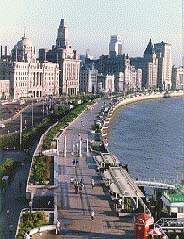 Japanese.
Japanese.
When a People's Republic was proclaimed
in China at the end of the civil war,foreigners
and Chinese industrialists, fleeing Communism,
left Shanghai, many re-establishing themselves
in Hong Kong.
Because of the city's long history
of foreign capitalist exploitation and 'bourgeois
attitudes', adherents of the Cultural Revolution
in the 1960s and '70s were particularly vociferous
in Shanghai, which became the headquarters of
the so-called Gang of Four, the ultra-Leftist
elements of this chaotic period.
When China began to reform her economic
system and opened her doors to the outside world,
one imagined that there would be a resurgence
of the entrepreneurial spirit in Shanghai. But
it took some while for today's momentum to build.
Until recently, Shanghai has been starved of
investment, Bejing having siphoned off much
of its huge earnings. As the population continued
to grow, the problems of housing and traffic
congestion grew ever more acute.
However, in 1988, Bejing and Shanghai
entered a new revenue agreement. Instead of
surrendering more than three-quarters of its
annual revenues, Shanghai began contributing
a fixed amount to the central government and
keeping any surpluses for its own use. The revitalizing
of Shanghai could scarcely be more ambitiousf
bridges, tunnels, ah urban subway System, Suburban
housing, the technical upgrading and expansion
of its textile industry, the building of a microelectronics
industry in Caohejing, a would-be Silicon Valley;
and the establishment of a new port and free
trade and export processing zone in Pudong.
• Shanghai
• River Rites
• What
to See in Shanghai (1)
• What
to See in Shanghai (2)
• Shanghai's
History Through Its Names
• Cool Depths
• Revolutionary
Sites
• Excursions
from Shanghai

